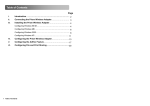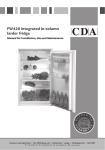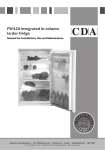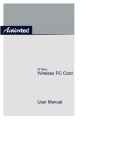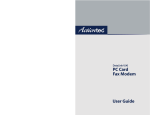Download Actiontec electronic 802UI3(b) Network Card User Manual
Transcript
Page Table of Contents l. Introduction 2 ll. Contacting Technical Support 3 lll. Connecting the Actiontec USB Wireless Adapter 4 lV. Installing the Actiontec USB Wireless Adapter 5 V. Configuring Windows 98 SE 5 Configuring Windows ME 8 Configuring Windows 2000 10 Configuring the Actiontec USB Wireless Adapter 14 Vl. Configuring the AdHoc Feature 16 Vll. Configuring File and Print Sharing 17 Proprietary Notice and Disclaimer Unless otherwise noted, this document and the information herein disclosed are proprietary to Actiontec Electronics, Inc the manufacturer. Any person or entity to whom this document is furnished or who otherwise has possession thereof, by acceptance agrees that it will not be copied or reproduced in whole or in part, nor used in any manner except to meet the purposes for which it was delivered. The information in this document is subject to change without notice and should not be construed as a commitment by Actiontec the manufacturer. Although Actiontec the manufacturer will make every effort to inform users of substantive errors, Actiontec the manufacturer disclaims all liability for any loss or damage resulting from the use of this document or any hardware or software described herein, including without limitation contingent, special or incidental liability. Note: PC is a trademark of IBM Corporation. Windows 98 and 98 SE is a trademark of Microsoft Inc. All other brand or product names and logos used in this manual are trademarks or registered trademarks of their respective holders. 0530-0262-000 Table of Contents 1 l Introduction Thank you for purchasing the Actiontec USB Wireless Adapter. This USB Wireless Adapter is easy to use and easy to setup. If you are tired off all those messy wires just to connect a laptop to your Home network, then take your networking to the next level with the Actiontec USB Wireless Adapter. You will be able to share files, printers and even your High-Speed Internet access, all without wires. Contacting Technical Support Actiontec Electronics prides itself on making high-quality, durable, high-performance products. If you should need assistance, the Actiontec Technical Support Department is available 6 am to 11pm Mon - Sun (Central Time), to provide professional support. Package Contents Make sure the following items came in this package: USB Wireless Adapter USB Cable Actiontec USB Wireless Adapter Installation CD-ROM This User’s Manual and Quick Start Installation Guide Actiontec Electronics, Inc. 760 N. Mary Avenue Sunnyvale, CA 94085 Phone: 1-719-884-8300 E-mail: [email protected] Minimum System Requirements One Pentium class computer, 200 Mhz or higher (preferably 300 Mhz or above) Microsoft Windows 98 Second Edition (SE), Microsoft ME, Microsoft 2000 installed 2 Introduction Contacting Technical Support 3 ll Connecting the Actiontec USB Wireless Adapter 1. It will not affect the installation process if your computer is on or off. However, if your computer is off then after you have connected the USB Wireless Adapter, please be sure to turn on your computer. lll Installing the Actiontec USB Wireless Adapter For Windows 98 1. After you have installed the USB Wireless Adapter your computer will display an “Add New Hardware Wizard” screen. Click Next. 2. Insert the Actiontec USB Wireless Adapter into the appropriate USB slot on either the front or the back of your PC. lV 2. In the next screen, select the option Search for the best driver for your device and then click the Next button. 4 Connecting the Actiontec USB Wireless Adapter Installing the Actiontec USB Wireless Adapter 5 3. Please insert the Actiontec USB Wireless Adapter Installation CD into your CDROM drive. Select CD-ROM Drive and then click Next. 5. The USB Adapter’s properties screen will appear. (Note: The “SSID” must be the same as the “ESSID” on your Home Gateway or Access Point.) Click OK to complete the installation process. lV lV 4. Your computer will locate the correct drivers named “AEIWLNIC.inf”. Click Next to install the drivers. 6. The installation is now complete. Please click Finish . 6 Installing the Actiontec USB Wireless Adapter Installing the Actiontec USB Wireless Adapter 7 7. It will be necessary for you to shut down your computer. Please click OK to restart your computer. If this screen does not appear please restart your computer manually. 2. The USB Adapter’s properties screen will appear. (Note: The “SSID” must be the same as the “ESSID” on your Home Gateway or Access Point.) Click OK to complete the installation process. lV lV Windows ME 1. After you have installed the USB Wireless Adapter your computer will display an “Add New Hardware Wizard” screen. Click Automatic search for a better driver (Recommended). Then click the Next button. 3. The installation is now complete. Please click Finish. 8 Installing the Actiontec USB Wireless Adapter Installing the Actiontec USB Wireless Adapter 9 4. It will be necessary for you to shut down your computer. Please click OK to restart your computer. If this screen does not appear please restart your computer manually. 2. In the next screen, select the option Search for the best driver for your device and then click the Next button. lV lV For Windows 2000 1. After you have installed the USB Wireless Adapter your computer will display the “Found New Hardware Wizard” screen. Click Next. 10 Installing the Actiontec USB Wireless Adapter 3. Please insert the Actiontec USB Wireless Adapter Installation CD into your CDROM drive. Select CD-ROM Drive and then click Next. Installing the Actiontec USB Wireless Adapter 11 4. Your computer will locate the correct drivers named “AEIWLNIC.inf”. Click Next to install the drivers. 6. If you have configured any Encryption capabilities in your Home Gateway or Access Point then complete the following screen accordingly. Otherwise, please click Finish to complete the installation process. lV lV 5. The “Wireless LAN Configuration Utility” screen will appear. (Note: The “SSID” must be the same as the “ESSID” on your Home Gateway or Access Point.) Click OK to continue the installation process. 12 Installing the Actiontec USB Wireless Adapter Installing the Actiontec USB Wireless Adapter 13 Configuring the Actiontec USB Wireless Adapter After you have installed the software for the Actiontec USB Wireless Adapter an, Icon will appear in your Task Bar on the lower right hand side on your Desktop. You will not be automatically connected to your Home Gateway or Access Point. Follow these steps to configure your Actiontec USB Wireless Adapter. Actiontec USB Adapter Status Icon V 1. Right click on the Actiontec USB Adapter Status Icon. A list will appear as shown in the picture below. Make sure that there is a black dot next to the Turn Wireless Radio On. If the dot is not present then simply select it. Then you want to select the Advanced Configuration... selection from the given list. 3. After you have entered the appropriate SSID value click Apply and then click OK. Your Actiontec USB Adapter will now be able to connect to your Home Gateway or Access Point. If your Home Gateway or Access Point is connected to a DSL or Cable modem then test your wireless connection. You can do this by opening your Internet Browser and then surf the web. Note: There are two colored bars on either side of the Actiontec USB Wireless Adapter Icon. When they are Green it means that your wireless connection is strong or good. When they are Yellow it means that your wireless connection is fair. When they are Red it means that your wireless connection is poor or weak. When the bars are Yellow or Red you may experience slower connection speeds then when they are Green. V Encryption (WEP) You can use Encryption to add a level of security to your USB Wireless Adapter network. This is not a required feature. If you are using a Home Gateway or Access Point you must be sure to use the same Encryption (WEP) keys for your USB Wireless Adapter. Please follow these steps to set this feature up: 1. Right click on the Actiontec USB Adapter Status Icon. A list will appear as shown in the picture on the previous page. Then select Advanced Configuration... from the given list. 2. Click on the Encryption tab. 2. The USB Wireless Adapter’s Properties screen will appear. Under the “Configuration” tab the SSID value should be the same as the ESSID value of your Home Gateway or Access Point. For example, if you have configured your Home Gateway or Access Point’s ESSID value to “ACTIONTEC” then this same value needs to be typed into the SSID field in the following screen. 14 Configuring the Actiontec USB Wireless Adapter 3. You can either select 64 bit or 128 bit Encryption depending on your needed level of security. You can select Create Keys with Passphrase (a passphrase is the same as a password, with the same type of functionality). Once you have entered a pass phrase the utility will automatically generate the 4 keys. Remember, if you are using a Home Gateway or Access Point these keys will need to be added to it. If you already have a set of keys configured into your Home Gateway or Access Point or you prefer to create the keys manually, select Create Keys Manually and enter them in the given fields. Click Apply and then OK to activate your settings. Configuring the Actiontec USB Wireless Adapter 15 Configuring the AdHoc feature Configuring File and Print Sharing AdHoc enables two or more computers with the USB Wireless Adapter to talk to each other. The most common usage for this feature is multi-player games in which each player can play the game from each computer against one another via this Adhoc network. If you use the AdHoc feature then a Home Gateway or Access Point is not required. Please follow these steps to set up the AdHoc feature: If you have and are using a Home Gateway or Access Point you can establish a network that will allow you to share files and printers. This is an easy method to set up a network in your home or small office. Please follow these steps to setup file and print sharing: 1. Right click on the Actiontec USB Adapter Status Icon. A list will appear as shown in the picture below. Then select Advanced Configuration... from the given list. 1. On your computer’s desktop click Start, then select Settings and then select Control Panel. In the “Control Panel” window double click the Network icon. For Windows 95, 98 and ME 2. The following “Network” screen should appear. Click the Add button. Vl Vll 2. In the “Profile” field type in any name you wish. This will save all the settings under that name. Then click on the down arrow in the “Mode” field and select 802.11 AdHoc. Enter an SSID value in the given field. The SSID value should be the same on each computer that you want to network together. Then in the “AdHoc Channel” box select a channel between the numbers 1-11. This value also must be the same on each computer that you wish to network. Finally, click Apply and OK to activate the settings. Be sure to repeat this for each computer you want to network. 3. In the “Select Network Component Type” screen, click Service and then click the Add button. 16 Configuring the AdHoc Feature Configuring File and Print Sharing 17 4. In the following screen please select File and printer sharing for Microsoft Networks from the given list. Vll 5. In the “File and Print Sharing” screen make sure that both of the selection have a check mark beside them. If they do not please click on the box next to each statement and then click OK. Vll 7. Click on the Configuration tab. This will take you back to the screen from step 2. In the “Primary Network Logon:” box, located just above the “File and Print Sharing” button, make sure that Client for Microsoft Networks is selected. If it is not then click the down arrow and select it from the given list. Click OK. 8. A screen will appear asking you to restart your computer. Click Yes to restart the computer. If you do not see this screen please restart your computer manually. After your computer restarts you will be asked to supply a User Name and Password. Enter whatever you would like but be sure to write down these values, as they will enable you to access your network. 6. After you have clicked OK you will return to the network screen from step 2. Please click on the Identification tab (see the first image on page 26). Computer Name: In this field you can type any name you want. (i.e. My Computer, John, CPU654) Do not use the same name for each computer you wish to have on your network. Workgroup: This field enables you to set a unique name for your network. This name must be set up on every other computer you wish to have on your network. Computer Description: You can enter anything you wish. Traditionally, the location name or main user’s name is used in this field. 18 Configuring File and Print Sharing Configuring File and Print Sharing 19 9. After your computer has restarted and you entered a password and user name, you must enable a file or drive for sharing. Locate the file or drive you wish to share. (The easiest way to achieve this is through your Windows Explorer, located in the start menu.) Right click on the File or Drive you wish to share. In the given menu select Sharing. ther restrict their privlidges by entering a password in the appropriate field. Full: This will allow other users on your network to read, modify, move and delete any information in the shared drive or file. You can further restrict their privlidges by entering a user name and password. Depends on Password: This will allow you to set both Read Only and Full access on the shared file or drive. The level of access will depend on the passwords you enter in the appropriate field. When you are finished click Apply and then OK. Vll Vll 10. The following screen will appear. Please select Shared As. This will enable other users on your network to see the file or drive you selected. Then you can chose the Access Type: 11. Next you need to share your printer. On your desktop, click Start, click Settings, and then select Printers. 12. Right click on the printer you want to share. Select “Sharing” from the given list. Read Only: This will allow other users on your network to view and read the file or drive you selected. They will not be able to modify it in any way. You can fur20 Configuring File and Print Sharing Configuring File and Print Sharing 21 13. The next step will be to enable the sharing by selecting the “Share As” button. It will automatically insert a default name for the Share Name. You may set a password for the printer at this time if you want to restrict who on the network can use this resource. You may also set the default printer settings by modifying information on the other tabs of this window. 3. In the “Computer Name:” box type a name that is different from your other PC’s on your network. Then, in the “Workgroup” box type the name that you are using to identify your network. This will be the same on each computer on your network. Click OK and you will return to the “Network Properties” screen. Click OK again and even if you are not asked to do so, please restart your computer. For Windows 2000 1. After you have installed and configured your USB Adapter, Windows 2000 will automatically enable file and print sharing for your computer. The only item that needs to be altered is your workgroup settings. All the computers on your network must have the same workgroup name but different computer names. To check or change this locate the “My Computer” icon on your desktop. Right click on it and select Properties from the given list. Vll 2. In the “System Properties” click on the Network Identification tab. If the “Workgroup” name is already the same as all the other computers on your network, then you do not need to change it. Click OK. If it is not the same then click Properties. 22 Configuring File and Print Sharing Vll Configuring File and Print Sharing 23 Notes: 24













